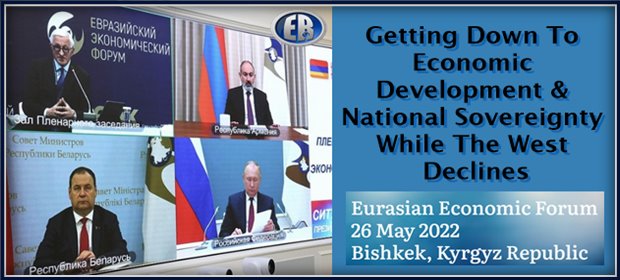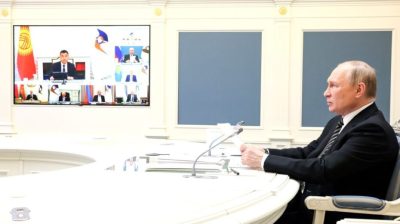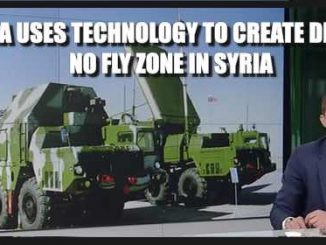
The Eurasian Economic Union Steps Up
The Eurasian Economic Forum has shown once again that this high-speed – economic integration – train has already left the station.
PEPE ESCOBAR

All Global Research articles can be read in 51 languages by activating the “Translate Website” drop down menu on the top banner of our home page (Desktop version).
To receive Global Research’s Daily Newsletter (selected articles), click here.
Visit and follow us on Instagram, Twitter and Facebook. Feel free to repost and share widely Global Research articles.
***
The first Eurasian Economic Forum, in Bishkek, Kyrgyzstan, took place this week at a very sensitive geopolitical juncture, as Russian Foreign Minister Sergei Lavrov keeps stressing that,
“the West has declared total war against us, against the entire Russian world. Nobody even hides this now.”
It’s always important to remember that before Maidan in 2014, Ukraine had the option to become a full member of the Eurasian Economic Union (EAEU), and even balance it with a loose association with the EU.
The EAEU comprises five full members – Russia, Kazakhstan, Kyrgyzstan, Belarus and Armenia – yet 14 nations sent delegations to the forum, including China, Vietnam and Latin American nations.
There was much rumbling that the proceedings would be jeopardized by the serial sanctions packages imposed on Russia by the collective West. There’s no question that some EAEU members – such as Kazakhstan – seem to be more worried about the effects of the sanctions than about fine-tuning business with Russia. Yet that’s not the point.
The crucial point is that by 2025, they have to harmonize their legislation concerning financial markets. And that’s directly connected to what the executive body of the EAEU, led by Sergey Glazyev, is working on, extensively: designing the lineaments of an alternative financial/economic system to what the West would rather coin as Bretton Woods 3.
The Eurasian Economic Forum was established by the Supreme Eurasian Economic Council explicitly to further deepen economic cooperation between EAEU members. No wonder the official theme of the forum was Eurasian Economic Integration in the Era of Global Shifts: New Investment Opportunities, focusing on strategic development in the industrial, energy, transport, financial, and digital areas.
So Many Converging Strategies
President Putin’s speech to the plenary session was quite revealing. To really appreciate the scope of what’s implied, it’s important to remember that the Greater Eurasian Partnership concept was presented by Putin in 2016 at the St. Petersburg Economic Forum, focused on a “more extensive Eurasian partnership involving the Eurasian Economic Union” and including China, Pakistan, Iran and India.
Putin stressed how the drive for developing ties “within the framework of the Greater Eurasian Partnership” (…) “was not the political situation but global economic trends, because the centre of economic development is gradually – we are aware of this, and our businesspeople are aware of this – is gradually moving, continues to move into the Asia-Pacific Region.”
He added, “in the current international conditions when, unfortunately, traditional trade and economic links and supply chains are being disrupted”, the Greater Eurasian Partnership “is gaining a special meaning.”
Putin established a direct connection not only between the Greater Eurasian Partnership and EAEU members but also “BRICS members such as China and India”, “the Shanghai Cooperation Organization, ASEAN and other organizations.”
And that’s the core of the whole, ongoing, multi-layered process of Eurasia integration, with the China-led New Silk Roads intersecting with the Eurasia Economic Union, the SCO, BRICS+, and other converging strategies.
Lavrov this week said that Argentina and Saudi Arabia want to join BRICS, whose next summer in China is being meticulously prepared. Not only that: Lavrov mentioned how quite a few Arab nations want to join the SCO. He was careful to describe this process of converging alliances as “not antagonistic”.
Putin for his part was careful to define the Greater Eurasian Partnership as “a big civilizational project. The main idea is to create a common space for equitable cooperation for regional organizations”, changing “the political and economic architecture on the entire continent.”
Thus, the necessity to “draft a comprehensive strategy for developing large-scale Eurasian partnership”, including “a roadmap for industrialization”. That translates in practice as developing “engineering centers and research centers. This is inevitable for any country that wants to increase its economic, financial, and ultimately political sovereignty. It is inevitable.”
Yaroslav Lissovolik at the Valdai Club is one of the top analysts tracking how this convergence may profit the whole Global South. He stresses that among the “variability and diversity in the platforms that may be launched by Global South economies, the most sizeable and comprehensive of which could include the aggregation of CELAC (Latin America), African Union (Africa)”, and the SCO in Eurasia.
And an even more diverse set of “regional blocs that targets deeper integration could feature a BRICS+ platform that comprises the South African Development Community (SADC), MERCOSUR, BIMSTEC”, the China-ASEAN free trade agreement, and the EAEU.
The Eurasian Economic Forum has shown once again that this high-speed – economic integration – train has already left the station. It’s quite enlightening to notice the sharp contrast with the endless doom and gloom afflicting a collective West prone to inflation, energy shortages, food shortages, fictional “narratives” and the defense of neo-Nazis under the banner of liberal “democracy”.
************
Source
Pepe Escobar, born in Brazil, is a correspondent and editor-at-large at Asia Times and columnist for Consortium News and Strategic Culture in Moscow. Since the mid-1980s he’s lived and worked as a foreign correspondent in London, Paris, Milan, Los Angeles, Singapore, Bangkok. He has extensively covered Pakistan, Afghanistan and Central Asia to China, Iran, Iraq and the wider Middle East. Pepe is the author of Globalistan – How the Globalized World is Dissolving into Liquid War; Red Zone Blues: A Snapshot of Baghdad during the Surge. He was contributing editor to The Empire and The Crescent and Tutto in Vendita in Italy. His last two books are Empire of Chaos and 2030. Pepe is also associated with the Paris-based European Academy of Geopolitics. When not on the road he lives between Paris and Bangkok.
He is a regular contributor to Global Research.
Featured image is licensed under public domain

••••
The Liberty Beacon Project is now expanding at a near exponential rate, and for this we are grateful and excited! But we must also be practical. For 7 years we have not asked for any donations, and have built this project with our own funds as we grew. We are now experiencing ever increasing growing pains due to the large number of websites and projects we represent. So we have just installed donation buttons on our websites and ask that you consider this when you visit them. Nothing is too small. We thank you for all your support and your considerations … (TLB)
••••
Comment Policy: As a privately owned web site, we reserve the right to remove comments that contain spam, advertising, vulgarity, threats of violence, racism, or personal/abusive attacks on other users. This also applies to trolling, the use of more than one alias, or just intentional mischief. Enforcement of this policy is at the discretion of this websites administrators. Repeat offenders may be blocked or permanently banned without prior warning.
••••
Disclaimer: TLB websites contain copyrighted material the use of which has not always been specifically authorized by the copyright owner. We are making such material available to our readers under the provisions of “fair use” in an effort to advance a better understanding of political, health, economic and social issues. The material on this site is distributed without profit to those who have expressed a prior interest in receiving it for research and educational purposes. If you wish to use copyrighted material for purposes other than “fair use” you must request permission from the copyright owner.
••••
Disclaimer: The information and opinions shared are for informational purposes only including, but not limited to, text, graphics, images and other material are not intended as medical advice or instruction. Nothing mentioned is intended to be a substitute for professional medical advice, diagnosis or treatment.




